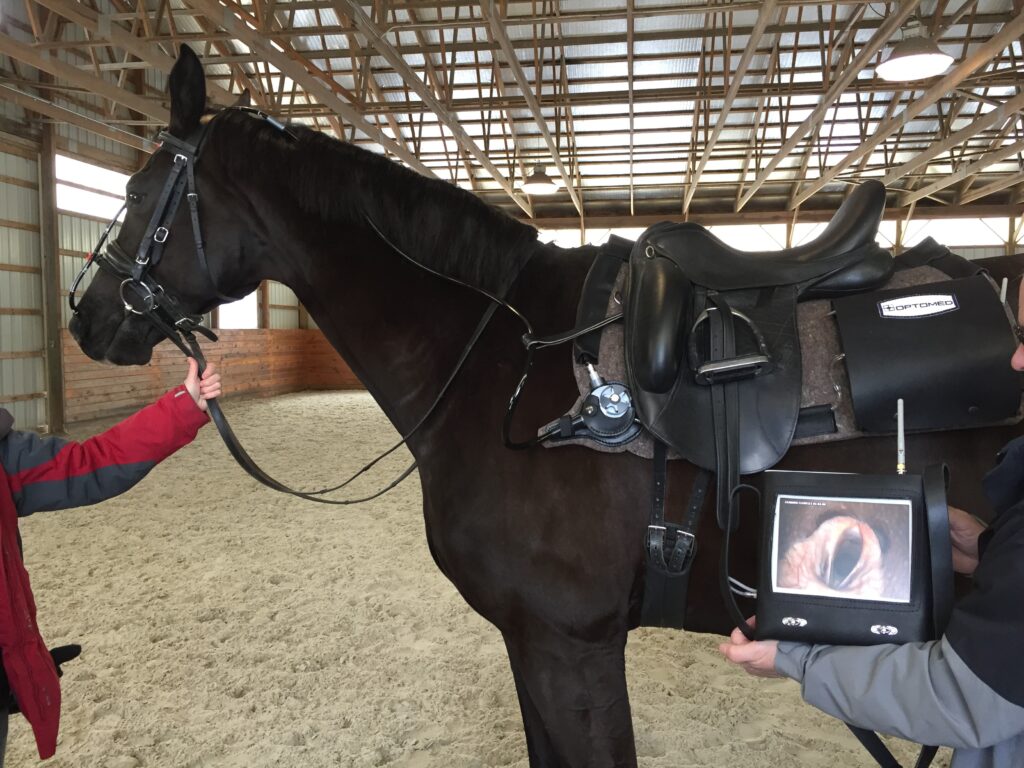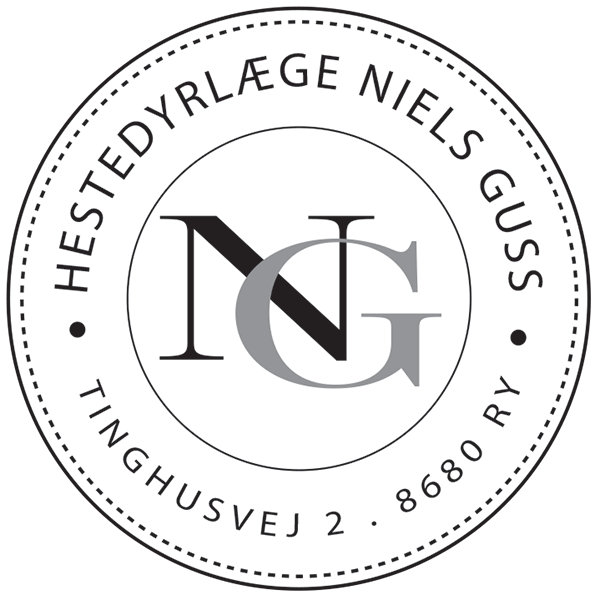Disorder in the upper and lower respiratory tract is one of the main reasons for reduced ability to
perform among our riding horses today.
This Category clearly overtakes the category of lameness!
Through many years we have performed endoscopic examinations of the horses while resting. Today,
it has been proved that it is during work/in motion that the horse has a problem.
Now we can get even closer to observe what happens in the horse's respiratory tract when in motion.
This is done with a so-called fiberscope, which is a long tube with a light and a camera at the tip.
How is this done?
The fiberscope it put up through the horse's nasal cavity and into the throat where several disorders can be diagnosed.
Furthermore, the scope can be led down the trachea, all the way down into the bronchial tree,
into the lungs.
This technique has worked very well.
At the same time, it has been possible to watch the horses on a high-speed treadmill to see in this way how the upper respiratory tract, in particular the throat,
acts when the horse is moving.
This procedure is not completely without a risk, since some horses do not like running on a treadmill.
Panic and tension may inflict injury on the horse,
it may fall on the belt or completely panic and fall off.
At the same time,
we have to recognise that the way the horse works on a treadmill may be miles away from the way it acts under a rider working in familiar surroundings.
There is a difference in the horse’s posture when being ridden compared with when it walks more freely!
A minor abnormal respiratory sound during work,
reduced performance or work tolerance may still be present in spite of a normal endoscopic examination during rest.
We may go as far as to say that up to 90 % of the respiratory disorders that result in problems during work with the riding horse,
can only be diagnosed on a proper basis by having the horse in its normal work conditions.
Meaning if we can work the horse under normal conditions in our own arena.
After all, this is where we most often see the beginning of the problems.
This can be done.
Namely with a new piece of equipment called “Overground Dynamic Endoscopy”
Overground Dynamic Endoscopy – what is it?
A small fiberscope, flexible hose with a camera and a small light at the end, can be from the saddle pad
is placed over the horse's head and led up into the nasal cavity to the throat. The scoop is attached to the horse's
head with a special halter, which at the same time gives the opportunity to wear headgear. The camera
connected with a recorder etc., placed as a base for the saddle.
The scoop is not larger than the vast majority of horses accept the presence of this during work
after a few minutes.
Recorder as well as computer makes it possible to evaluate the horse at work and review the recording
later or have others evaluate it at a later time.
Furthermore, the system has a microphone which is placed by the horse's throat, fastened to the headstall.
This furthermore makes it possible to record sounds during the work from the horse's throat.
For example, the degree of abnormal sound in a horse with whistling
So, we have a tool that will enable us, on-site, to progress with diagnosing the horse with a given
respiratory problem. At the same time, we can record the findings to document as well as share and
discuss them with colleagues after finishing the examination.
On the other hand, we can also use the equipment to show that a given abnormal sound etc.
does not bother the horse during work!
We have to understand that with this equipment we can monitor the horse's throat during work.
And we have to understand that the horse’s exchange of air exclusively takes place through its nasal cavity.
This means that disorders that have to do with the air exchange will show in the throat.
We can make a more certain diagnosis
To begin with, it was expected that by using dynamic endoscopy it was expected that the number of
operations in the upper respiratory tract of the horse would rise significantly. Fact is the exact opposite!
We have now obtained ocular proof of what happens and that the main part of the disorders cannot be established at rest.
We began to see many things related to the respiratory tract.
For example, we can see that a bit that may seem too hard on the horse makes it position the tongue in
such a way that the rearmost part of the palate, which is soft, is pushed up into the throat. This causes
the “air exchange” to be compromised with a reduced amount of oxygen for the horse as consequence.
The horse may also have a sore throat, which has the result that it does not work appropriately, but
braces against the bit, positions it head in a certain way and thereby does not function when being ridden.
There may also be disorders such as throat collapse where the horse’s whole throat collapses during work.
Here we can imagine that the horse will more or less panic during work due to choking
sensations.
In certain cases, an examination of the upper respiratory tract may give rise to examination of the
lower respiratory tract of the horse. If the horse has a lung condition similar to asthma, this disorder
will constitute the basis for a changed pressure in the horse’s throat, which may cause the upper
respiratory tract to appear more collapsed. The horse may have a healthy throat, but instead the
discovery may lead to a diagnosis of a disorder in the lungs. And here we progress regarding diagnosis.
A number of horses with an abnormal sound during work, also called whistling. This disorder is a full or
part lameness of the arytenoid cartilage in the left side of the horse. It is possible to perform an
operation for this, but is it always necessary? No.
With dynamic endoscopy we can follow the horse, and we find that a number of the horses, in spite of an abnormal sound / whistling, can work without a given operation for this.
On the other hand, we also see a number of horses where we have to accept that it takes an operation,
if they are to perform at a given level.
Shall a dynamic endoscopy examination be a part of pre-purchase examinations of the future?
For the riding horse's work, the position of head and poll during work is extremely important. The more
we flex / bend the head, the more we compromise the horse’s exchange of air. If the horse already has
a problem in the upper respiratory tract, it will really manifest itself here. Therefore, it is easy to
imagine, in the future, that dynamic endoscopy will enter the picture, for example at a pre-purchase
examination, to document that the horse’s respiratory tract is okay at a given time of trading. Now that
we have in mind that respiratory tract disorders strongly overtake for instance lameness in the group
of reduced performance level in the riding horse.
With dynamic endoscopy we have come far in the understanding of what happens in the horse's
respiratory tract. We can perform the examination in the horse's familiar surroundings and we can document what we are seeing!
I believe that we can help many more horses in the future!



